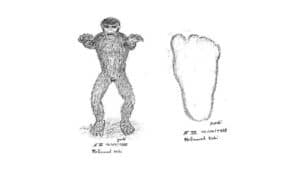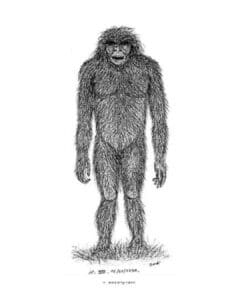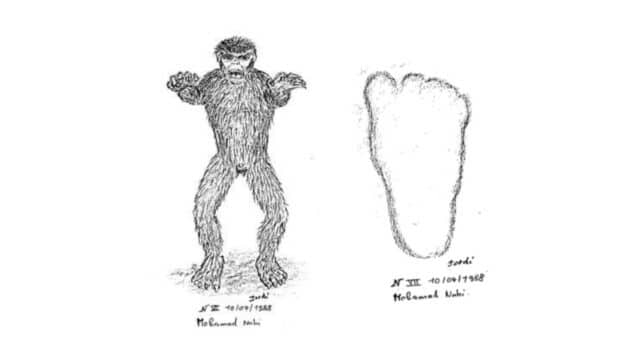
In the rugged, mountainous regions of northern Pakistan, a creature shrouded in mystery and folklore roams the wilds—or so the stories go. Known as the Barmanou (or Barmanu, Baddmanus), this bipedal, humanoid primate is often dubbed Pakistan’s equivalent of Bigfoot. With a reputation for its ape-like appearance, foul odor, and alleged penchant for abducting women, the Barmanou has captured the imagination of locals, cryptozoologists, and skeptics alike. A recent Reddit thread on r/bigfoot sparked renewed interest in this elusive cryptid, prompting us to dive deeper into its lore, the evidence, and the cultural significance it holds.
What is the Barmanou?
The Barmanou is a legendary cryptid from northern Pakistan, described as a bipedal, ape-like creature 6-8 feet tall, covered in dark hair, with a human-like face and foul odor. Known as the “Big Hairy One,” it inhabits the Chitral and Karakoram Ranges and is linked to tales of abducting women. Some speculate it’s a surviving Neanderthal or Gigantopithecus.
The Legend of the Barmanou
The Barmanou is said to inhabit the Chitral and Karakoram Ranges, a remote and treacherous landscape nestled between the Pamir Mountains and the Himalayas. This places it geographically between two other famous cryptids: the Yeti of the Himalayas and the Almas of Central Asia.

The name “Barmanou,” derived from the Khowar language, translates to “Big Hairy One” or “Forest Man” and is used across several Pakistani languages, including Urdu, Shina, Pashto, and Kashmiri. Local folklore describes the creature as a hybrid of human and ape, standing 6 to 8 feet tall, covered in dark brown or black hair, with a muscular build and a human-like face featuring a prominent brow ridge, deep-set eyes, and a flat nose.
Shepherds and villagers in the region have long shared tales of encounters with the Barmanou, often accompanied by descriptions of its horrific stench—likened to rotting garbage, a skunk, or a musky goat. Some accounts claim the creature wears animal skins on its back and head, adding to its wild, primitive appearance. Perhaps most chilling are the stories of the Barmanou’s behavior: it is said to be nocturnal, reclusive, and occasionally aggressive, with a disturbing tendency to abduct women for mating purposes, a motif that echoes similar cryptid legends worldwide.
In Chitrali oral tradition, the Barmanou is sometimes romanticized, drawing parallels to “Beauty and the Beast.” Locals claim it is drawn to beautiful women, a detail that blends myth with cultural storytelling. Coincidentally, though, this tracks with Native American warnings that Sasquatch occasionally will abduct women.
Unlike supernatural entities like jinns or shape-shifting demons, the Barmanou is consistently described as a flesh-and-blood creature, not a spiritual being. This distinction has fueled speculation that it could be a surviving relic of an ancient hominid, or a relative of America’s Bigfoot.
Never Miss A Paranormal Story!
Newsletter subscribers get insider access to the latest paranormal posts!
Your email is safe with us and you can unsubscribe at any time!
The Search for Evidence

The Barmanou’s most notable researcher was Spanish zoologist Jordi Magraner, who dedicated over a decade to tracking the creature. From 1987 to 2002, Magraner conducted fieldwork in Pakistan’s Chitral region, interviewing locals and collecting over 50 firsthand sighting accounts. His work, detailed in the paper Les Hominidés reliques d’Asie Centrale, suggested the Barmanou could be a living Neanderthal or a similar hominid, a theory supported by eyewitnesses who identified drawings of Heuvelman’s Homo pongoides (a hypothesized ape-like man) as matching the creature they saw.
In May 1992, Magraner, along with Dr. Anne Mallasseand and another associate, reported hearing unusual guttural sounds in the Shishi Kuh Valley of Chitral. Described as originating from a “primitive voice-box,” these vocalizations were unlike any known animal in the region. Unfortunately, the team couldn’t record the sounds or pursue the creature due to fading light. Despite these tantalizing clues, Magraner’s research remained inconclusive, and his life was tragically cut short in 2002 when he was murdered in Afghanistan under mysterious circumstances, possibly linked to the region’s political turmoil.
Other expeditions, such as one by the Center for Fortean Zoology in 2009, have also searched for the Barmanou but returned empty-handed. A 2014 photograph circulating on Pakistani media, allegedly showing the creature, remains unverified, and no physical evidence—bones, hair, or clear footprints—has been scientifically validated. The lack of concrete proof keeps the Barmanou firmly in the realm of cryptozoology, where belief often outpaces evidence.
Cultural Context and Skepticism
The Barmanou’s legend is deeply woven into the fabric of northern Pakistan’s culture, particularly in Chitral and the Allai Valley. Stories of the creature are passed down through generations, often tied to the region’s rugged terrain and isolation. Some locals, like a Department of Forest officer named Ghulam Fareed, have claimed personal encounters, such as being stalked by a mysterious creature in 2004. Others, however, view the Barmanou as folklore, possibly inspired by misidentified animals like bears or exaggerated tales of hermits living in the wild.
Skeptics argue that the Barmanou could be a cultural archetype, akin to the “wildman of the woods” found in global mythologies. The creature’s similarities to Bigfoot, Yeti, and the Almas suggest a universal human fascination with humanoid beasts that embody the untamed aspects of nature. Financial incentives, such as boosting tourism, may also perpetuate the legend, as seen in other cryptid hotspots worldwide. Additionally, the absence of recent abduction reports, despite historical claims, casts doubt on the creature’s existence.
From a scientific perspective, the Barmanou’s existence is plausible but unlikely without physical evidence. The region’s dense forests and inaccessible valleys could theoretically hide an undiscovered primate, but the lack of fossils or genetic material challenges the hypothesis. Comparisons to Gigantopithecus, a massive extinct ape, or Neanderthals are speculative, as no evidence suggests these species survived into modern times. Misidentification of known animals, like the Himalayan brown bear, or cultural storytelling, may explain many sightings.
Why the Barmanou Matters
Whether the Barmanou is a real creature or a product of folklore, its story resonates for several reasons. First, it highlights the power of oral tradition in preserving cultural narratives, especially in remote regions where storytelling is a vital link to the past. Second, it underscores the human fascination with the unknown, a trait that drives exploration and scientific inquiry, even if the results are inconclusive. Finally, the Barmanou serves as a reminder of the wild, untamed places that still exist on Earth—places where mysteries can persist in the face of modern skepticism.
For cryptozoology enthusiasts, the Barmanou offers a tantalizing challenge: a creature with enough eyewitness accounts to spark curiosity but too little evidence to confirm its existence. For the people of Chitral and beyond, it’s a symbol of their land’s enigma, a “Forest Man” who embodies the untouchable spirit of the mountains. Until definitive proof emerges, the Barmanou will remain what it has always been—a shadow in the peaks, a whisper in the valleys, and a story that refuses to die.
Have you heard of the Barmanou or similar cryptids in your region? Share your thoughts in the comments below, and let’s keep the conversation going!
Images from: https://www.isu.edu/media/libraries/rhi/research-papers/MAGRANER-formatted.pdf












One Response